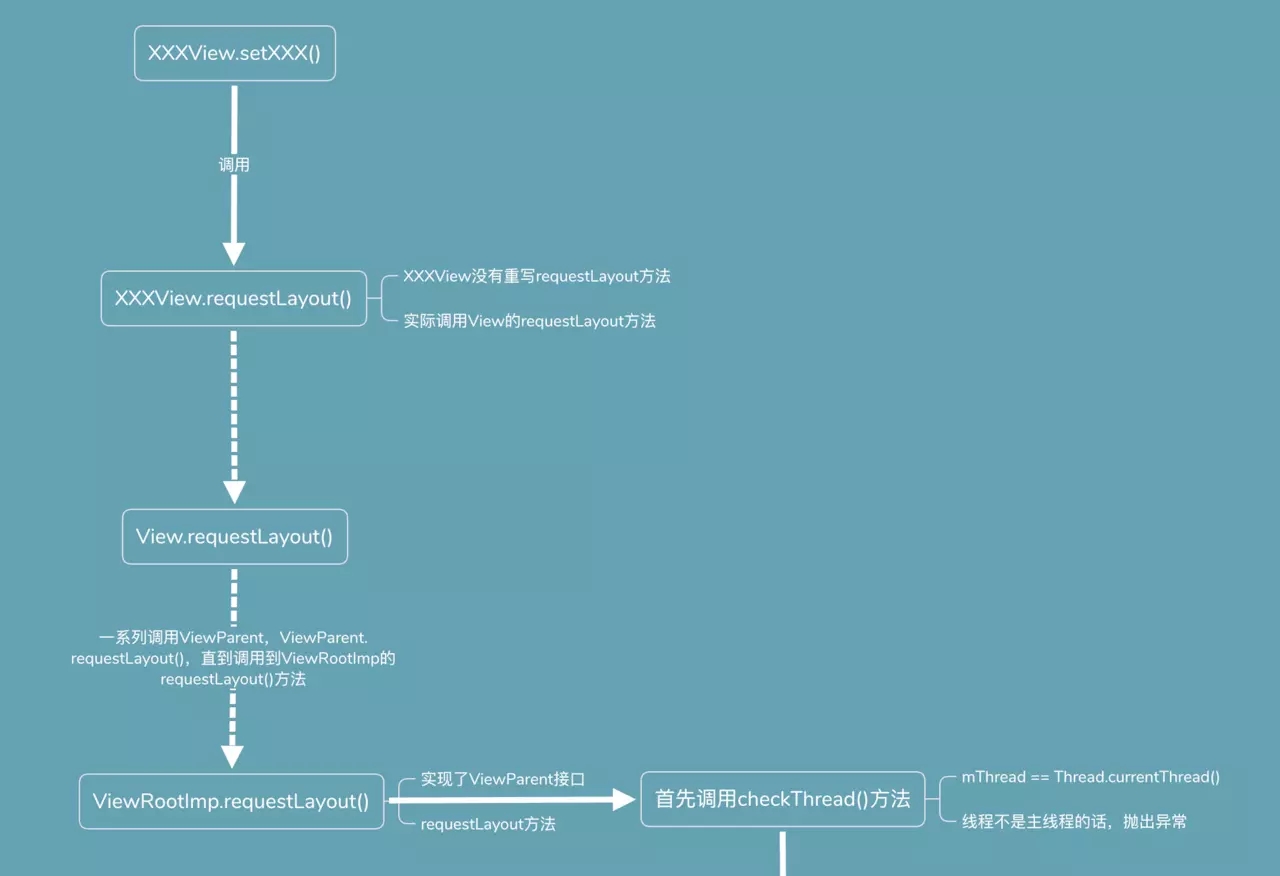您好,登錄后才能下訂單哦!
您好,登錄后才能下訂單哦!
這篇文章主要為大家展示了“Android子線程與更新UI的示例分析”,內容簡而易懂,條理清晰,希望能夠幫助大家解決疑惑,下面讓小編帶領大家一起研究并學習一下“Android子線程與更新UI的示例分析”這篇文章吧。
引子:
情形1
@Override
protected void onCreate(Bundle savedInstanceState) {
super.onCreate(savedInstanceState);
setContentView(R.layout.activity_main);
TextView textView = findViewById(R.id.home_tv);
ImageView imageView = findViewById(R.id.home_img);
new Thread(new Runnable() {
@Override
public void run() {
textView.setText("更新TextView");
imageView.setImageResource(R.drawable.img);
}
}).start();
}運行結果:正常運行!!!
情形二
@Override
protected void onCreate(Bundle savedInstanceState) {
super.onCreate(savedInstanceState);
setContentView(R.layout.activity_main);
TextView textView = findViewById(R.id.home_tv);
ImageView imageView = findViewById(R.id.home_img);
new Thread(new Runnable() {
@Override
public void run() {
try {
Thread.sleep(5000);
} catch (InterruptedException e) {
e.printStackTrace();
}
textView.setText("更新TextView");
imageView.setImageResource(R.drawable.img);
}
}).start();
}運行結果:異常
android.view.ViewRootImpl$CalledFromWrongThreadException: Only the original thread that created a view hierarchy can touch its views.
at android.view.ViewRootImpl.checkThread(ViewRootImpl.java:6357)
at android.view.ViewRootImpl.requestLayout(ViewRootImpl.java:874)
at android.view.View.requestLayout(View.java:17476)
at android.view.View.requestLayout(View.java:17476)
at android.view.View.requestLayout(View.java:17476)
at android.view.View.requestLayout(View.java:17476)
at android.view.View.requestLayout(View.java:17476)
at android.view.View.requestLayout(View.java:17476)
at android.widget.RelativeLayout.requestLayout(RelativeLayout.java:360)
at android.view.View.requestLayout(View.java:17476)
at android.widget.TextView.checkForRelayout(TextView.java:6871)
at android.widget.TextView.setText(TextView.java:4057)
at android.widget.TextView.setText(TextView.java:3915)
at android.widget.TextView.setText(TextView.java:3890)
at com.dong.demo.MainActivity$1.run(MainActivity.java:44)
at java.lang.Thread.run(Thread.java:818)
不是說,子線程不能更新UI嗎,為什么情形一可以正常運行,情形二不能正常運行呢;
子線程修改UI出現異常,與什么方法有關
首先從出現異常的log日志入手,發現出現異常的方法調用順序如下:
TextView.setText(TextView.java:4057)
TextView.checkForRelayout(TextView.java:6871)
View.requestLayout(View.java:17476)
RelativeLayout.requestLayout(RelativeLayout.java:360)
View.requestLayout(View.java:17476)
ViewRootImpl.requestLayout(ViewRootImpl.java:874)
ViewRootImpl.checkThread(ViewRootImpl.java:6357)
更改ImageView時,出現的異常類似;
首先看TextView.setText()方法的源碼
private void setText(CharSequence text, BufferType type,
boolean notifyBefore, int oldlen) {
//省略其他代碼
if (mLayout != null) {
checkForRelayout();
}
sendOnTextChanged(text, 0, oldlen, textLength);
onTextChanged(text, 0, oldlen, textLength);
//省略其他代碼然后,查看以下checkForRelayout()方法的與源碼。
private void checkForRelayout() {
// If we have a fixed width, we can just swap in a new text layout
// if the text height stays the same or if the view height is fixed.
if ((mLayoutParams.width != LayoutParams.WRAP_CONTENT
//省略代碼
// We lose: the height has changed and we have a dynamic height.
// Request a new view layout using our new text layout.
requestLayout();
invalidate();
} else {
// Dynamic width, so we have no choice but to request a new
// view layout with a new text layout.
nullLayouts();
requestLayout();
invalidate();
}
}checkForReLayout方法,首先會調用需要改變的View的requestLayout方法,然后執行invalidate()重繪操作;
TextView沒有重寫requestLayout方法,requestLayout方法由View實現;
查看RequestLayout方法的源碼:
public void requestLayout() {
//省略其他代碼
if (mParent != null && !mParent.isLayoutRequested()) {
mParent.requestLayout();
}
if (mAttachInfo != null && mAttachInfo.mViewRequestingLayout == this) {
mAttachInfo.mViewRequestingLayout = null;
}
}View獲取到父View(類型是ViewParent,ViewPaerent是個接口,requestLayout由子類來具體實現),mParent,然后調用父View的requestLayout方法,比如示例中的父View就是xml文件的根布局就是RelativeLayout。
@Override
public void requestLayout() {
super.requestLayout();
mDirtyHierarchy = true;
}繼續跟蹤super.requestLayout()方法,即ViewGroup沒有重新,即調用的是View的requestLayout方法。
經過一系列的調用ViewParent的requestLayout方法,最終調用到ViewRootImp的requestLayout方法。ViewRootImp實現了ViewParent接口,繼續查看ViewRootImp的requestLayout方法源碼。
@Override
public void requestLayout() {
if (!mHandlingLayoutInLayoutRequest) {
checkThread();
mLayoutRequested = true;
scheduleTraversals();
}
}ViewRootImp的requestLayout方法中有兩個方法:
一、checkThread,檢查線程,源碼如下
void checkThread() {
if (mThread != Thread.currentThread()) {
throw new CalledFromWrongThreadException(
"Only the original thread that created a view hierarchy can touch its views.");
}
}判斷當前線程,是否是創建ViewRootImp的線程,而創建ViewRootImp的線程就是主線程,當前線程不是主線程的時候,就拋出異常。
二、scheduleTraversals(),查看源碼:
void scheduleTraversals() {
if (!mTraversalScheduled) {
mTraversalScheduled = true;
mTraversalBarrier = mHandler.getLooper().getQueue().postSyncBarrier();
mChoreographer.postCallback(
Choreographer.CALLBACK_TRAVERSAL, mTraversalRunnable, null);
if (!mUnbufferedInputDispatch) {
scheduleConsumeBatchedInput();
}
notifyRendererOfFramePending();
pokeDrawLockIfNeeded();
}
}查看mTraversalRunnable中run()方法的具體操作
final class TraversalRunnable implements Runnable {
@Override
public void run() {
doTraversal();
}
}繼續追蹤doTraversal()方法
void doTraversal() {
if (mTraversalScheduled) {
mTraversalScheduled = false;
mHandler.getLooper().getQueue().removeSyncBarrier(mTraversalBarrier);
if (mProfile) {
Debug.startMethodTracing("ViewAncestor");
}
performTraversals();
if (mProfile) {
Debug.stopMethodTracing();
mProfile = false;
}
}
}查看到performTraversals()方法,熟悉了吧,這是View繪制的起點。

總結一下:
1.Android更新UI會調用View的requestLayout()方法,在requestLayout方法中,獲取ViewParent,然后調用ViewParent的requestLayout()方法,一直調用下去,直到調用到ViewRootImp的requestLayout方法;
2.ViewRootImp的requetLayout方法,主要有兩部操作一個是checkThread()方法,檢測線程,一個是scheduleTraversals,執行繪制相關工作;
情形3
@Override
protected void onCreate(Bundle savedInstanceState) {
Log.i("Dong", "Activity: onCreate");
super.onCreate(savedInstanceState);
setContentView(R.layout.activity_main);
new Thread(new Runnable() {
@Override
public void run() {
Looper.prepare();
try {
Thread.sleep(5000);
} catch (InterruptedException e) {
e.printStackTrace();
}
Toast.makeText(MainActivity.this, "顯示Toast", Toast.LENGTH_LONG).show();
Looper.loop();
}
}).start();
}運行結果:正常
分析
下面從Toast源碼進行分析:
public static Toast makeText(Context context, CharSequence text, @Duration int duration) {
return makeText(context, null, text, duration);
}makeText方法調用了他的重載方法,繼續追蹤
public static Toast makeText(@NonNull Context context, @Nullable Looper looper,
@NonNull CharSequence text, @Duration int duration) {
Toast result = new Toast(context, looper);
LayoutInflater inflate = (LayoutInflater)
context.getSystemService(Context.LAYOUT_INFLATER_SERVICE);
View v = inflate.inflate(com.android.internal.R.layout.transient_notification, null);
TextView tv = (TextView)v.findViewById(com.android.internal.R.id.message);
tv.setText(text);
result.mNextView = v;
result.mDuration = duration;
return result;
}新建了一個Toast對象,然后對顯示的布局、內容、時長進行了設置,并返回Toast對象。
繼續查看new Toast()的源碼
public Toast(@NonNull Context context, @Nullable Looper looper) {
mContext = context;
mTN = new TN(context.getPackageName(), looper);
mTN.mY = context.getResources().getDimensionPixelSize(
com.android.internal.R.dimen.toast_y_offset);
mTN.mGravity = context.getResources().getInteger(
com.android.internal.R.integer.config_toastDefaultGravity);
}繼續查看核心代碼 mTN = new TN(context.getPackageName(), looper);
TN初始化的源碼為:
TN(String packageName, @Nullable Looper looper) {
//省略部分不相關代碼
if (looper == null) {
// 沒有傳入Looper對象的話,使用當前線程對應的Looper對象
looper = Looper.myLooper();
if (looper == null) {
throw new RuntimeException(
"Can't toast on a thread that has not called Looper.prepare()");
}
}
//初始化了Handler對象
mHandler = new Handler(looper, null) {
@Override
public void handleMessage(Message msg) {
switch (msg.what) {
case SHOW: {
IBinder token = (IBinder) msg.obj;
handleShow(token);
break;
}
case HIDE: {
handleHide();
// Don't do this in handleHide() because it is also invoked by
// handleShow()
mNextView = null;
break;
}
case CANCEL: {
handleHide();
// Don't do this in handleHide() because it is also invoked by
// handleShow()
mNextView = null;
try {
getService().cancelToast(mPackageName, TN.this);
} catch (RemoteException e) {
}
break;
}
}
}
};
}繼續追蹤handleShow(token)方法:
public void handleShow(IBinder windowToken) {
//省略部分代碼
if (mView != mNextView) {
// remove the old view if necessary
handleHide();
mView = mNextView;
Context context = mView.getContext().getApplicationContext();
String packageName = mView.getContext().getOpPackageName();
if (context == null) {
context = mView.getContext();
}
mWM = (WindowManager)context.getSystemService(Context.WINDOW_SERVICE);
/*
·*省略設置顯示屬性的代碼
·*/
if (mView.getParent() != null) {
if (localLOGV) Log.v(TAG, "REMOVE! " + mView + " in " + this);
mWM.removeView(mView);
}
= try {
mWM.addView(mView, mParams);
trySendAccessibilityEvent();
} catch (WindowManager.BadTokenException e) {
/* ignore */
}
}
}通過源碼可以看出,Toast顯示內容是通過mWM(WindowManager類型)的直接添加的,更正:mWm.addView 時,對應的ViewRootImp初始化發生在子線程,checkThread方法中的mThread != Thread.currentThread()判斷為true,所以不會拋出只能在主線程更新UI的異常。
以上是“Android子線程與更新UI的示例分析”這篇文章的所有內容,感謝各位的閱讀!相信大家都有了一定的了解,希望分享的內容對大家有所幫助,如果還想學習更多知識,歡迎關注億速云行業資訊頻道!
免責聲明:本站發布的內容(圖片、視頻和文字)以原創、轉載和分享為主,文章觀點不代表本網站立場,如果涉及侵權請聯系站長郵箱:is@yisu.com進行舉報,并提供相關證據,一經查實,將立刻刪除涉嫌侵權內容。